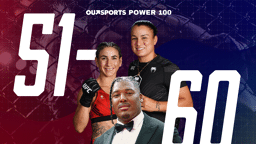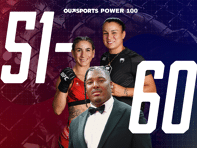This was my 12th summer celebrating pride. Rather than pride, I find a better fitting word for me is “confidence”. Yes, I am so proud of the journey I have taken as a trans man and athlete, but I’m confident that those experiences are going to propel me to further success.
If we’re talking pride then I’m mostly proud that I survived it, struggles in all, and that my passion for the sport of lacrosse has survived too.
I now recognize so many things that could have saved me some anguish when I was younger. During my undergrad years I was the starting lacrosse goalie, the gender-sexuality alliance (GSA) president, and I was terrified to come out…again.
I grew up in Eastern Massachusetts, and I knew from a young age that I was not like other girls. Being a tomboy made it very evident that I was appreciated for my differences.
I came out the first time as a lesbian early in high school. There was a lot of “we knew, we were waiting for you to tell us” from my friends, and a “You know that’s fine with us. Can you move so I can finish the laundry?” from my mom.
My mom was a tomboy too, a former lacrosse, field hockey, and rugby player. She grew up playing basketball in the days when girls weren’t allowed to run the full length of the court, pre-Title IX.
Most importantly for me, she coached me in soccer, basketball, lacrosse, and a few other sports until high school. Being the coach’s kid came with extra responsibilities. When necessary, I got put in the position that no one else wanted to play: goalie.
For a lacrosse goalie, you want one of your smartest and quickest athletes. And oh yeah, it should be someone who can somehow shut down every natural instinct to flinch from a hard rubber ball throttling toward them.
I loved it. The adrenaline rush of the save, the calculating fluidity of a 40-yard clear to a middy in stride, the beckoning for a double-team at the right time. There’s a real sense of power, and an honor in defending the goal-line.
Being a goalie was my identity, and the crease was a home away from home.
I got recruited to a private college north of Boston with about 3,000 undergrads. The successful teams were heralded, and the women’s lacrosse team was damn successful.
“Being a goalie was my identity, and the crease was a home away from home.”
But my first year – in 2010 – I recognized that another piece of my community was missing. There was no functioning GSA at Endicott College. So I started one with a couple other students. I got up close and personal with how the upper echelon of the school administration molds the image of the school, for better or worse. They seemed fine with people being LGBTQ+, as long as we weren’t “in your face” about it.
I have the power to tell my own story now because my school did not celebrate my journey, either publicly or privately. The majority of my campus, the faculty and staff were wonderful to me, but they were also woefully unprepared for a trans student.
For example, there were no policies for gender-neutral houseing. You could also only change your name on your ID if you had a legal document to back it up. In the athletic building there were single-stall bathrooms available only for refs, and they were locked for everyone else.
This is what happens when an approach to policy is “we’ll wait ‘til it happens here to change anything.” And that’s if they want to change.
On the women’s lacrosse team I always felt welcome, even before they knew the most authentic Ryan. A tribute to the values the coaches and players shared across the program.

It was at the school’s homecoming athletics awards ceremony when what made me different on the team actually made me stand out to all those around me.
Every team that had won a conference championship the previous year was there to celebrate. Conference-title banners were hung on the walls of the packed gym that day, but folded up. There was a ceremonial rope to pull for each of the banners, but things often don’t go as smoothly as planned.
By some miscalculation, the rope that the women’s lacrosse team was supposed to collectively pull to reveal our banner reached only the top of the closed set of bleachers, ending about 10 feet short. All of my teammates wore dresses, heels or sandals that day. All of my team, that is, except me.
I heard a few of my teammates saying I had to climb on up. In my button-down shirt and tie I scaled the bleacher set and pulled the tether as my team cheered from below. Hundreds of people applauded staring at me, cheering our accomplishment.
I felt very out of place. All of those people were staring at me, and the reason was how different I was from all my teammates. They all thought it was great that one of us was able to ascend to pull the rope, but it should have been all of us. Instead it was the only one who wore kahkis and Oxfords.
A couple weeks after the banner raising I came out to everyone, again. I had come to understand that I wasn’t gay, I was a guy. I was trans. As my sisters’ keeper, I couldn’t omit the truth from them anymore.
Coming Out 2.0 nearly killed me. I nearly killed me. I put the team above all else in an invisible seppuku ceremony. I came out as trans that previous summer, starting in June of 2013. I went into my senior year knowing I would have to wait nearly a year to access the testosterone that I was desperate for.
Each trans person has different priorities. My priority was my athletic identity, but in order to live with clarity I needed medical treatment banned by the NCAA. Like many transgender athletes, I decided that critical part had to wait until after graduation. I was a lacrosse player, and I was fighting an internal war between two identities that could not simultaneously exist in the way I needed them to.
Being trans in sport is a big deal. It’s big because the athlete becomes a representative for a population connected in the shared experiences of resiliency. As soon as the label of trans-athlete is attached, a lot of attributions of assumed success get stuck to it. Your body is a threat to some people. Every breath, and every time you compete, becomes a political statement. All for the love of the game.
The team had just sat through a routine off-season meeting. I was trying not to sweat and pass out. Coach and I had already talked. Although she would rarely address the topic, she became one of my biggest supporters. She had all the game write-ups either change or omit all pronouns referring to me. Being able to see game recaps that didn’t misgender me was a huge boost for my self-confidence.
I approached the front of the room with hands shaking uncontrollably. I don’t remember exactly what I said, but I’m pretty sure it was a rapid blurting of facts.
“I’m transgender, my name is Ryan, I use he/him pronouns, don’t worry I’m not quitting the team.” Something to that effect, but probably a bit more blubbering.
Twenty-five faces stared back at me. Complete silence.
They were shocked. Some didn’t know what “transgender” was. This was 2013, before anyone had ever heard of Caitlyn Jenner. The only other trans athlete I knew then was Kye Allums.
Hearing I was trans, for some of my teammates, was as foreign to them as if I had been speaking Slavic while trying to explain components of aviation (I can do neither of those things). The rest of my friends were glowing in their warmth. My family was supportive but needed assurance that I was deadset in my choices.
“My teammates, a sisterhood, quickly welcomed a brother into their family.”
I don’t blame my team at all. That luke-warm confusion wasn’t an intended exile. My teammates, a sisterhood, quickly welcomed a brother into their family.
That season we were competing for our ninth straight conference championship, and we always had a target on our backs. My mental health was all over the place, and my performance that season followed suit. I drove coach nuts because I wasn’t my consistent self.
We didn’t have any sport psych or athletic counselors to go to, and despite coming out to my team and finding support, my mental health was in a tail-spin. Instead of playing to win, I was playing to not lose, and it showed in all my stats.

Since graduating from college I have struggled to find a home in lacrosse. I was able to coach a couple camps, but that’s about it. I feel really distant from the game that I was ready to give my life for.
I would love to play lacrosse again, in any league. If a women’s league would let me in, I’d be there in a heartbeat. But I fully realize that I’m a man. I should be playing with the men, although “short and light” aren’t the ideal two words to get a spot on a men’s team.
Most importantly, the rules are quite different between men’s and women’s lacrosse. The physical aspect of the game that is celebrated in the men’s game is illegal in the women’s game. The markings on the field are radically different. One of the few things in common for men and women in lacrosse is the name of the sport.
I know how to play women’s lacrosse. I don’t know how to play the men’s game.
I’ve also found college coaching opportunities hard to come by. I didn’t follow the traditional grad assistant route, but then again I’ve never been described as traditional. I’m not surprised that I lost some contacts when my name, voice, and face all changed.
For everything I have lost in and out of lacrosse, I have gained tenfold in my authenticity. I’m going to keep seeking out opportunities to engage in the game while I go through grad school.
My college career ended in 2014 with our ninth straight conference championship and trip to NCAA’s. Now, I get a weekly reminder in the form of a syringe of how much I’ve overcome, and I feel so much more at home in my bones.
Ryan Socolow is a graduate student at Springfield College studying sport psychology. He can be reached by email at [email protected], or on Instagram @rsoco24.





































